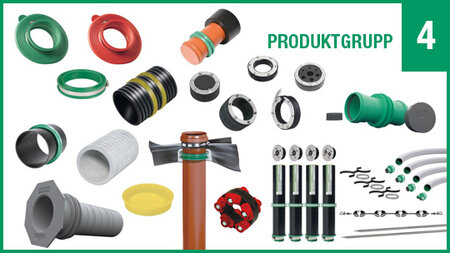Tryckvattentäta servicekanaler
Tryckvattentäta servicekanaler för rör och tillbehör

Husinföringssystem för el-, vatten- och kommunikationsanslutningar Testat enligt DVGW VP 601 (kapitel 4.5)...
Tätningsmanschetter tätar rör och kablar av plast, stål, fibrecement och vitrifierad lera mot höga vattenpelare. Genomföringarna i b...
Hålrör av PVC eller fibercement eller av rostfritt stål för införande av rör eller rörledningar i en konstruktion....
Vi erbjuder vägggenomföringssystem som kan ledas vattentätt in i byggnaden....
Vi erbjuder plåtgenomföringar i versionen orangebrun som PVC-U-system (KG) eller som rör av polypropylen (PP), färg grön. Leverera...
V2A-packningsinsatser i rostfritt stål för infodring av rör och kärnborrhål. Vi erbjuder många olika typer....
Modulär tätning - Förmonterad - Snabb och enkel installation - Testad upp till 30 m vattenpelare - Kan eftermonteras (alla p...
Plast-, ång- och vattentät tätningsmassa för vattenavvisande tätning av rör- och kabelkanaler under marknivå. Även lämplig för läc...
Här hittar du de tillbehör som behövs...
What role do house entries play in reinforced concrete construction?
The requirements for watertight concrete structures are regulated by the corresponding DAfStb guideline (WU guideline). In addition to requirements for the concrete structure itself, requirements for joint sealing and formwork anchors or tensioning points are defined here. The subject of this guideline is the corresponding planning and execution of the structure in order to fulfil the usage properties and usage requirements specified by the client with regard to the sealing function against water.
One point that is not taken into account in the directive, but which should not be neglected for the result of a watertight structure, is the sealing of pipes and cables that are routed through the concrete component. With our various house entries, we offer the right solution for almost every installation situation, regardless of whether it's a pipe penetration, casing pipe or house entry. Sealing compound can be used for sealing if water is already entering.
What are house entries used for?
Wherever pipes or other lines are routed through concrete components, they must be sealed against the ingress of water and/or gases such as methane gas or the radioactive radon gas sometimes present in the ground.
As the pipes and cables have different material properties to the concrete and the latter shrinks as it sets, there is a risk of circulation at the intersections of pipes and cables and the concrete. Water or gases can enter the building and create a risk of damage to the structure or even to the health of the people in the building.
How are house entries installed?
Depending on the type of house entry, this is either installed in the formwork before concreting or incorporated in the area of the base to be concreted. Subsequent installation in a core drill hole is also possible using our annular space seals and link chains. A pipe penetration or other media lines can be sealed by using wall collars.
There are special requirements for use in the agricultural sector. We have our JGS wall collar (RONDO Protect) in our programme for this purpose.





 engelska
engelska








